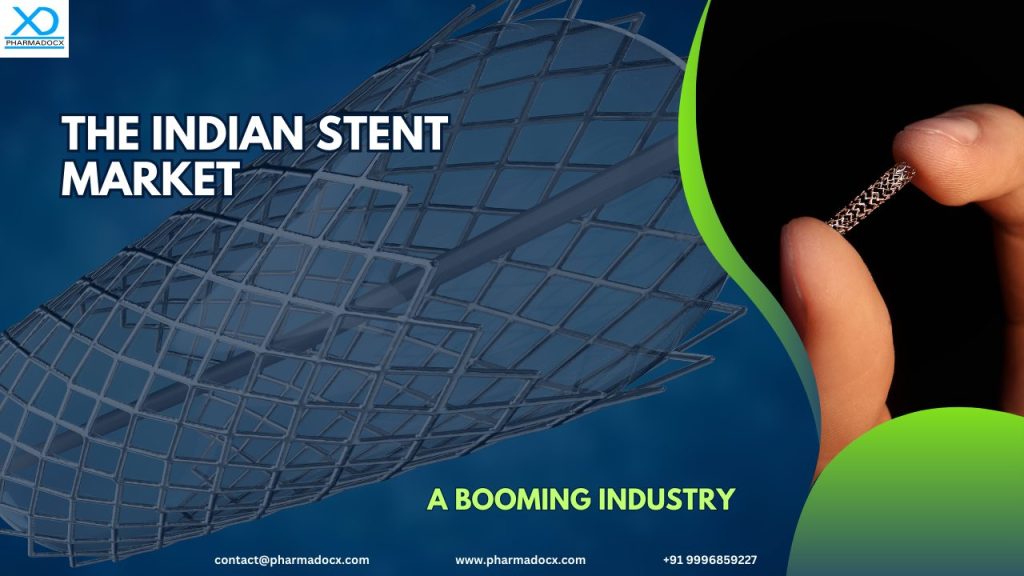Stents form the backbone of various minimally invasive surgeries, such as angioplasty. Read on to find out about the demand for stents in India. We have also provided an overview of the steps involved in manufacturing stents.
What are stents?
Stents are small expandable mesh tube-like structures inserted into arteries or other small tubes, such as ureters. They are used to clear out blockades or obstructions to ensure proper flow of body fluids through the tubes. For example, during angioplasty, they are used to clear the arteries of any blockage for improved blood flow. By ensuring proper blood flow, strokes or heart attacks can be prevented. Thus, stents have a very vital role in the healthcare industry.
What are the various types of stents used in healthcare settings?
Different types of stents have different intended function.
- Coronary stents: These stents are used to clear blockage in coronary arteries to improve blood flow. They are used to prevent and treat coronary artery diseases. These devices are of two types, bare metal coronary stents and drug-eluting stents. Bare metal coronary stents are not loaded with medications. Drug-eluting stents are loaded with medications to prevent inflammation and restenosis of the artery when used on a long-term basis.
- Oesophageal stents: These stents are used to keep the oesophagus open in case of oesophageal constriction. They offer relief to those patients with obstructions in the oesophagus caused by tumours or strictures.
- Biliary stents: These are used in the bile duct. Biliary stents are used to alleviate obstructions in the bile duct. They are used to maintain proper drainage of bile into the intestine.
- Peripheral arterial stents: These stents are used to prevent and treat peripheral artery disease. They are used to clear blockages or obstructions in peripheral arteries outside the coronary arteries.
- Urinary stents: A urinary stent is placed inside the ureter to allow the proper flow of urine from the kidney to the urinary bladder. The ureters are long tubes connecting the kidneys to the urinary bladder. Any obstruction in the ureter may hinder flow of urine from the kidney to bladder, which may damage the kidney. The urinary stent is used to clear the blockage in the ureters. However, this is a temporary measure until a surgery is performed to resolve the issue.
- Urethral and prostatic stents: These stents are used to keep the urethra open to allow proper flow of urine from the bladder to out of the body. The urethra is a tube that carries urine from the urinary bladder to outside of the body. Usually, enlargement of the prostate closes the urethra and prevents the flow of urine. Hence, the urethral stent is used to open up the urethra.
- Stent grafts: These stents are used for vascular surgeries, such as those used to treat abdominal aortic aneurysm. They are tubular devices made using a special fabric supported by a rigid metal stent.
Demand for stents in India
The Indian stent market is a booming industry. In the year 2022, the market size of this industry sector was estimated at USD 309.6 million. The Indian stent market size is expected to touch USD 426.49 million by 2029, growing at a CAGR of 4.76%. The Indian market comprises local manufacturers and importers that supply stents to clinics, hospitals, and other healthcare facilities.
There is a high demand for stents in India. Rise in number of patients with cardiovascular diseases and increase in demand for minimally invasive surgeries are the major growth drivers. Minimally invasive surgeries, such as angioplasty, have advantages, such as small incisions and fast recovery time, over traditional surgical procedures. Advancement in stent technology had led to improved patient outcome. Also, India has witnessed an increase in healthcare spendings. Hence, a greater number of patients are opting for these surgeries, which has increased the demand for stents in India.
Recently, the Indian government has capped the price of stents, thereby making them affordable to many. This has fuelled the rise in use of stents in healthcare treatment. Hence, local stent manufacturers selling low-cost stents have been placed at a competitive advantage. Companies selling expensive imported stents have lost a considerable market share. All these factors are fuelling the demand for manufacturing stents in India.

Manufacturing high quality and affordable stents in India will cater to the high unmet demand in India. Types of stents sold in India are bare-metal stents, drug-eluting stents, and bioresorbable stents.
The Indian stent market can be divided into the following segments:
- Material: Metallic Biomaterial, Polymer Biomaterial, and Natural Biomaterial
- Product: Coronary Stents, Peripheral Stents, Urinary stents, Urethral and prostatic stent, and Stent-related Implants
- End user: Hospital and Ambulatory Surgical Centres
- Region: North India, South India, East India, and West India
In the Indian stent market, the metallic biomaterial stent segment holds the highest market share. This is because metallic biomaterials are commonly used to manufacture stents owing to their high strength, durability, and compatibility. Furthermore, the coronary stents segment holds the highest share and are the most commonly used. Stent-related implants, which include stent grafts and implantable devices used in combination with stents, hold a relatively small market share. With respect to end-users, stent procedures are primarily performed in hospitals, thus they hold the highest share. The stent procedure is complex and requires specialized medical facilities and equipment. Hence, the hospitals hold a higher market share than ambulatory surgical centres.
Process of manufacturing stents
The manufacturing process for stents depends on several factors. The stent manufacturing process depends mainly on it intended use. Other factors, such as stent material, form, fabrication, and geometry, also influence the process of manufacturing stents.
Stent manufacturing process steps:
- Selecting the appropriate material: The material is selected depending on the stent’s intended use. Metals, such as cobalt-chromium, stainless steel, or nickel-titanium alloys, and polymers, namely nylon or polyurethane, are used to manufacture stents.
- Cutting the selected material: Laser is used to precisely cut and carve patterns on the stent structure. Patterns are carved in a manner to ensure when the stent expands in the vessel it can provide proper support.
- Polishing and smoothening of the cut stent: Electrochemical polishing technique is used to polish the edges to remove any imperfections and rough edges. This ensures the stent has a smooth and biocompatible surface.
- Sterilization: The stents are cleaned properly and then sterilized. Proper sterilization of these medical devices is a must owing to its intended application.
- Quality control: The manufactured stents are subjected to a robust quality control system. Patient safety and outcome depend on the quality and efficacy of the stent. These medical devices have to meet stringent quality benchmarks.
- Packaging: The stents have to be packaged properly in a sterile manner. The packaging should be able to protect the device from damage as well prevent the entry of pathogens.
Hence, manufacturing stents is a complex process requiring cutting edge technology and precision. Stents have revolutionized minimally invasive surgeries proving to be life saving for patients, especially for those with cardiovascular diseases. The patient outcome depends on the safety, efficacy, and quality of this medical device. Thus, the process of manufacturing stents is highly regulated.
Manufacturing stents in India
As mentioned previously, stents are in very high demand in India. Locally manufacturing stents in India would help meet the demands of high quality yet affordable stents. Hence, the process of manufacturing stents has to be strictly monitored to prevent the entry of substandard devices in India. CDSCO is the apex regulatory body for monitoring and controlling all medical devices manufactured in India. First, you have to secure a CDSCO manufacturing license to manufacture stents in India. Simply call/Whatsapp on 9996859227 or email at [email protected] to start your CDSCO manufacturing license application process. We at Pharmadocx Consultants will help simplify this complex license application process.





